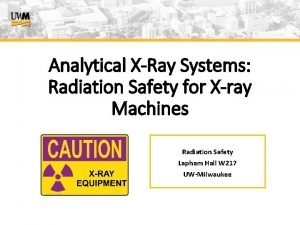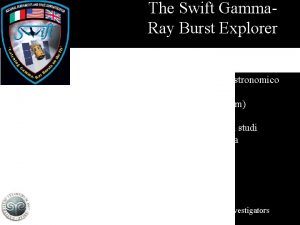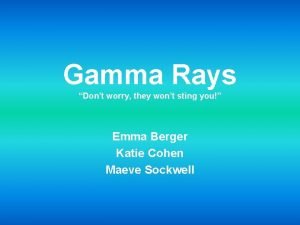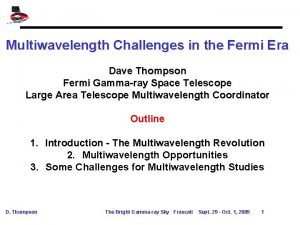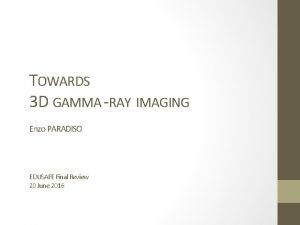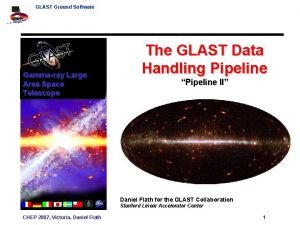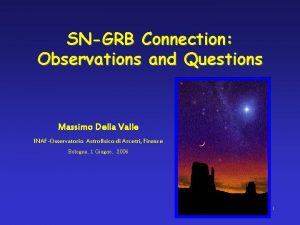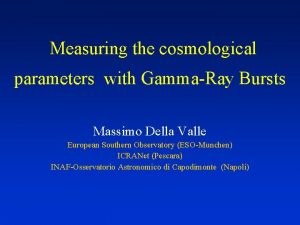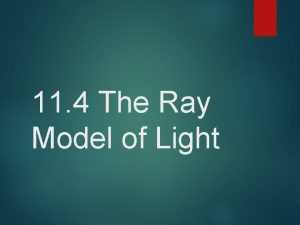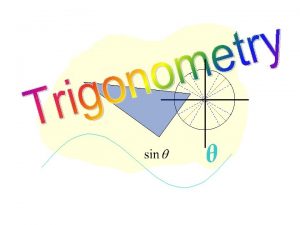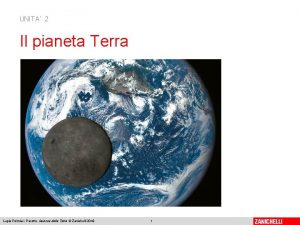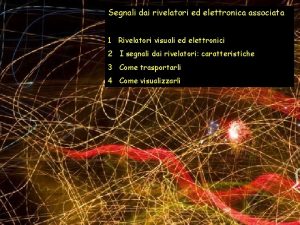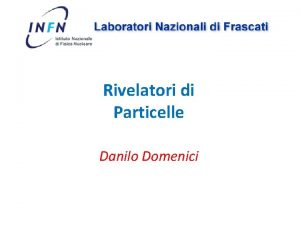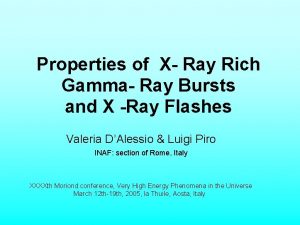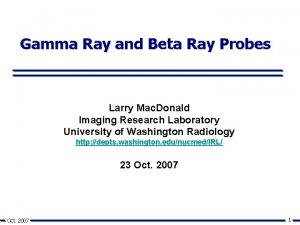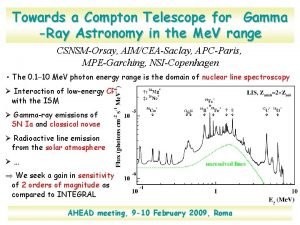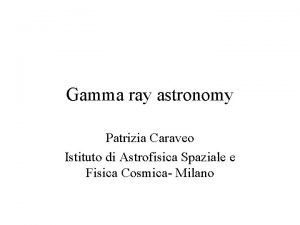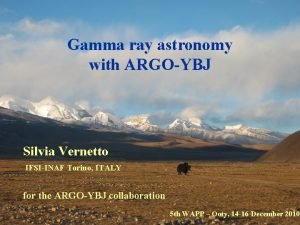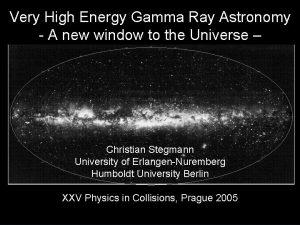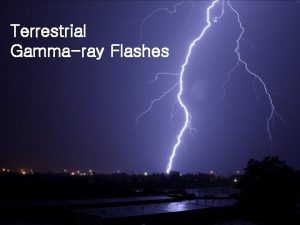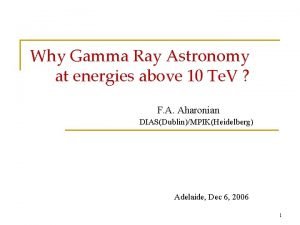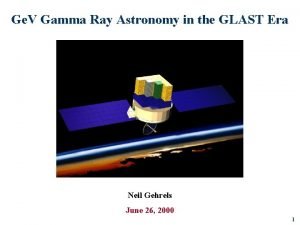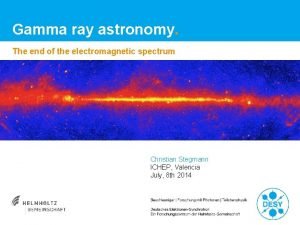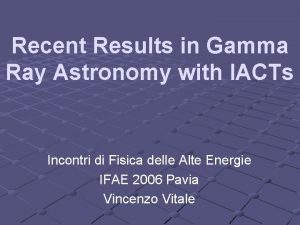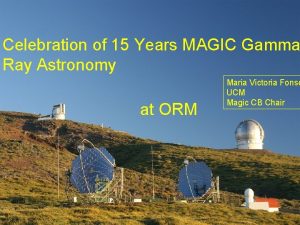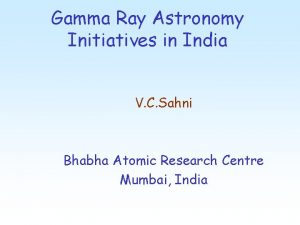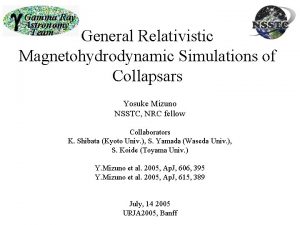Prospettive future della Gamma Ray Astronomy 1 Rivelatori










































- Slides: 42

Prospettive future della Gamma - Ray Astronomy 1) Rivelatori su satellite 2) Rivelatori Cerenkov 3) Particle Detector Array

Nuovi rivelatori su satellite • GLAST (lancio nel 2005) • AGILE (lancio inizio 2002) • AMS • PAMELA (lancio fine 2002)


GLAST Rivelatore “tracking” Rivelatore “Calorimetro”






The Alpha Magnetic Spectromer AMS




PAMELA, un magnete permanenete attrezzato con diversi rivelatori specializzati: • Spettrometro magnetico • Calorimetro e. m. con strip di silicio • TRD • TOF • Obiettivi di fisica : • raggi cosmici • antimateria • materia oscura PAMELA volerà a bordo del satellite russo Resusrs che verrà lanciato nel dicembre 2002 in un orbita tra 300 e 600 km di altezza,


Nuovi rivelatori AIR CERENKOV TELESCOPE • STACEE. USA solar array 70 ->50 Ge. V • CELESTE, Fr solar array 50 -> 25 Ge. V • VERITAS , USA 7 x 10 m 80 Ge. V • MAGIC , Spagna 17 m 30 -15 Ge. V • HESS, Namibia 4 x 12 m 60 Ge. V Ottima separazione h/g, grande area di raccolta luce, bassa soglia.

Solar Tower Atmospheric Cerenkov Effect Experiment

Caratteristiche di STACEE ex Solar Plant • Area rivelatori 2000 m 2 con soglia di 30 Ge. V • Area occupata dai rivelatori 20000 m 2 • Tecnologia ottica ad alto livello • Fast Read-out: 40 ADC 1 GHz per la ricostruzione degli EAS


The MAGIC Telescope Project MAGIC's original construction goal (in 1998): first light recorded in summer 2001


VERITAS

VERITAS The array will consist of seven 34 -foot-aperture optical telescopes placed at the corners and center of a hexagon with 279 -foot-long sides. Each large reflector will have a sophisticated camera at its focus. Threshold Energy 50 -70 Ge. V Angular resolution 0. 05 deg Energy resolution 15%



Nuovi rivelatori Particle Detector Array • MILAGRO • TIBET III • ARGO-YBJ

Physcs with MILAGRO • AGN • GRB • Solar Physics

MILAGRO L’apparato Milagro consiste di una grande vasca (delle dimensioni di un campo di calcio) riempita d’acqua, e sigillata a tenuta di luce. Nella piscina sono installati 723 PMT. Il principio di funzionamento è quello di rivelare i fotoni Cerenkov emessi dalle particelle veloci che attraversano la piscina.


PM Interno del rivelatore Milagro primo del riempimento d’acqua




Fisica Solare Durante i periodi di forte attività solare vengono emesse particelle nel range dei Ge. V, che possono essere rilevate dall’apparato MILAGRO Evento di Coronal Mass Ejection (CME)

ARGO - YBJ

ARGO-YBJ


Physics with ARGO-YBJ 1) Gamma-ray astronomy at a ~100 Ge. V threshold energy. Several galactic and extagalactic point candidate sources can be monitored, with a sensitivity to unidentified sources better than 10% of the Crab flux. 2) Diffuse Gamma Rays from the Galactic plane, molecular clouds and SNR at Eg >100 Ge. V. 3) Gamma-Ray Burst physics with a sensitivity allowing the extension of the satellite measurements over the full Ge. V/Te. V energy range. 4) Anti-p/p ratio at energies from 300 Ge. V to Te. V not accessible to satellites, with a sensitivity adequate to distinguish between models of galactic or extragalactic anti-proton origin. 5) The primary proton spectrum in the 10 - 200 Te. V region, with sensitivity sufficient to detect a possible change of the slope of the energy spectrum. 6) Sun and Heliosphere physics including cosmic ray modulations at 10 Ge. V threshold energy, the continuous monitoring of the large scale structure of the interplanetary magnetic field and high energy gamma and neutron flares from the Sun.


MAGIC sensitivity based on the availability of high efficiency PMT’s All sensitivities are at 5 s. Cerenkov telescopes sensitivities (Veritas, MAGIC, Whipple, Hess, Celeste, Stacee, Hegra) are for 50 hours of observations. Large field of view detectors sensitivities (AGILE, GLAST, Milagro, ARGO are for 1 year of observation.


Astronomia - gamma Conclusioni • Enormi progressi negli ultimi anni. Attualmente siamo in una fase di attesa per la costruzione di nuovi telescopi • Crab sorgente di calibrazione • Le osservazioni attuali concordano su un meccanismo di accelerazione di elettroni seguito da IC. No “Smoking gun” per meccanismi adronici • Le sorgenti di RC (SNR) non danno forti segnali gamma. Dove sono le sorgenti di RC? • Gli AGN mostrano fenomeni di Flaring la cui origine è oscura • L’astronomia gamma nella regione Ge. V/Te. V e’ oggetto di un intenso programma di ricerca che darà i suoi risultati a breve
 Emozioni discrete
Emozioni discrete Prospettive didattiche/lisa
Prospettive didattiche/lisa Learning astronomy by doing astronomy activity 1 answers
Learning astronomy by doing astronomy activity 1 answers Learning astronomy by doing astronomy activity 1 answers
Learning astronomy by doing astronomy activity 1 answers Learning astronomy by doing astronomy activity 1 answers
Learning astronomy by doing astronomy activity 1 answers Future simple continuous perfect
Future simple continuous perfect By the time future perfect
By the time future perfect Gamma ray
Gamma ray Electromagnetic scale
Electromagnetic scale Swift gamma ray burst explorer
Swift gamma ray burst explorer Gamma ray burst
Gamma ray burst Gamma particle discovered by
Gamma particle discovered by Gamma ray sky
Gamma ray sky Gamma ray
Gamma ray Gamma-ray
Gamma-ray Massimo della gamma
Massimo della gamma Massimo della gamma
Massimo della gamma Ray ray model
Ray ray model Ray casting algorithm
Ray casting algorithm Unit circle tan
Unit circle tan Pei disturbo misto della condotta e della sfera emozionale
Pei disturbo misto della condotta e della sfera emozionale Culture e formati della televisione e della radio
Culture e formati della televisione e della radio Soluzioni il racconto della chimica e della terra
Soluzioni il racconto della chimica e della terra Serie di bowen
Serie di bowen La coccinella in cerca della felicità
La coccinella in cerca della felicità Seta origini
Seta origini Elena bettinelli
Elena bettinelli Il racconto della chimica e della terra soluzioni
Il racconto della chimica e della terra soluzioni Goal parafrasi
Goal parafrasi Prove della sfericità della terra
Prove della sfericità della terra Simonetta klein il racconto della chimica
Simonetta klein il racconto della chimica Soluzioni il racconto della chimica
Soluzioni il racconto della chimica Terzo principio fichte
Terzo principio fichte Soluzioni il racconto della chimica e della terra
Soluzioni il racconto della chimica e della terra Prove della sfericità della terra
Prove della sfericità della terra Il racconto della chimica e della terra
Il racconto della chimica e della terra F92 disturbi misti della condotta e della sfera emozionale
F92 disturbi misti della condotta e della sfera emozionale Tense chart for class 2
Tense chart for class 2 How to use present continuous for future
How to use present continuous for future Future continuous and future perfect
Future continuous and future perfect Future continuous future perfect exercises
Future continuous future perfect exercises 1 2 3 kondicional u engleskom jeziku
1 2 3 kondicional u engleskom jeziku Tenses summary
Tenses summary







